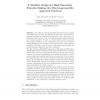122 search results - page 16 / 25 » Practical Threshold Signatures Without Random Oracles |
ASIACRYPT
2009
Springer
14 years 2 months ago
2009
Springer
The design of cryptographic hash functions is a very complex and failure-prone process. For this reason, this paper puts forward a completely modular and fault-tolerant approach to...
EUROCRYPT
2010
Springer
13 years 7 months ago
2010
Springer
We investigate the possibility to prove security of the well-known blind signature schemes by Chaum, and by Pointcheval and Stern in the standard model, i.e., without random oracle...
CCS
2004
ACM
14 years 26 days ago
2004
ACM
This paper describes the direct anonymous attestation scheme (DAA). This scheme was adopted by the Trusted Computing Group as the method for remote authentication of a hardware mo...
ATC
2007
Springer
14 years 1 months ago
2007
Springer
A proxy signature scheme allows an entity to delegate its signing capability to another entity (proxy) in such a way that the proxy can sign messages on behalf of the delegator. Pr...
SCN
2008
Springer
13 years 7 months ago
2008
Springer
We present an implementation of the protocol of Lindell and Pinkas for secure two-party computation which is secure against malicious adversaries [13]. This is the first running sy...

